Delicious blueberry jam is so easy to make. This small batch blueberry jam recipe is vibrantly coloured and busting with blueberry flavour, with just three ingredients and no pectin needed. Use fresh or frozen blueberries as you prefer.
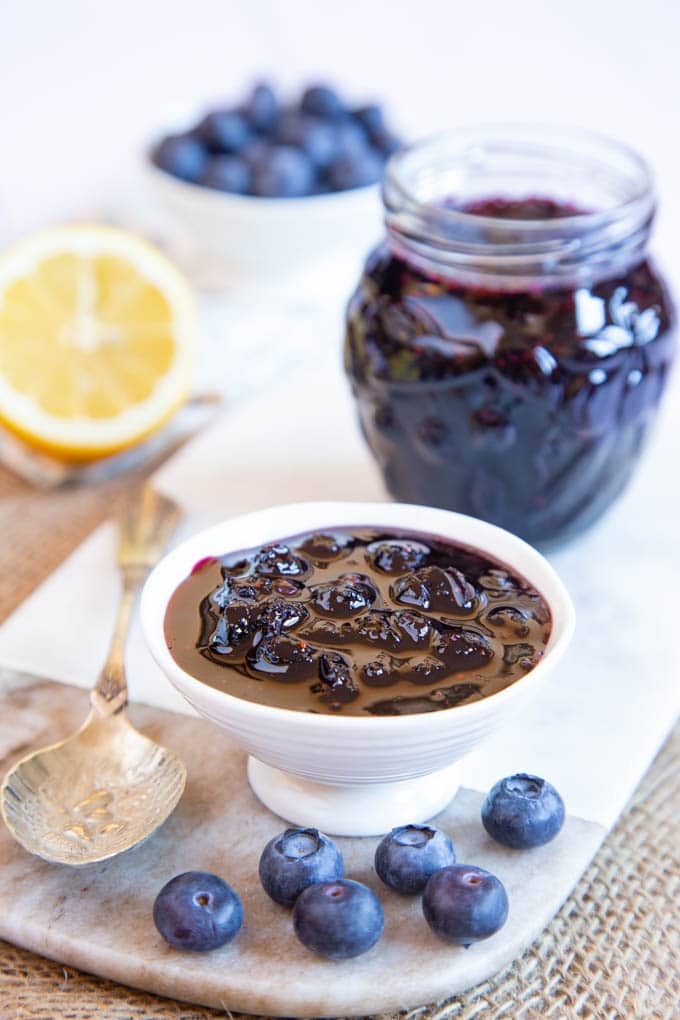
Blueberry Jam
I love making preserves, and this blueberry jam is currently my new favourite (until the next recipe)! It is just bursting with fresh juicy blueberries and is fantastic on toast, crumpets or stirred into a bowl of yogurt.
See Also
- Fig jam is easy and delicious with blue cheese
- Use a bag of berries from the freezer to make this mixed berry jam
- Small batch blackberry jam – when you have only managed to forage a few blackberries
I nearly always make small batch jams. They are quick to cook, and easy to experiment with, allowing you to play around with new flavours. Crucially you don’t need any special equipment like a preserving pan – a regular saucepan will do.
This blueberry jam recipe needs no pectin or jam sugar, and is simple and quick to make, using only blueberries, lemon juice and granulated sugar. The lemon juice has enough natural pectin to give the jam a lovely soft set.
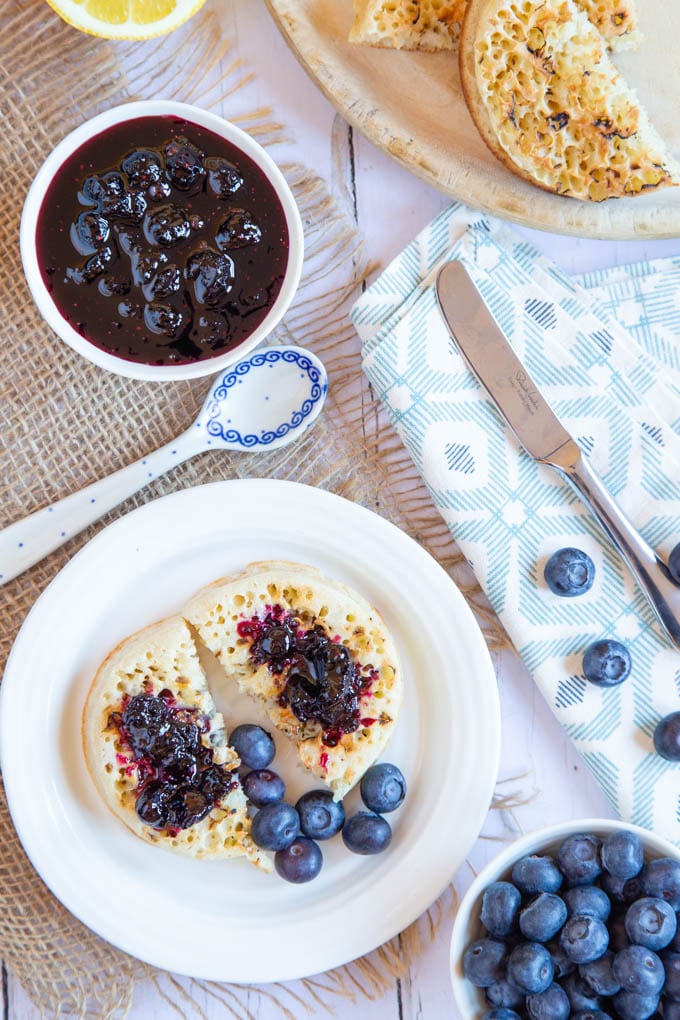
Can I Use Frozen Blueberries?
You can make this jam using either fresh or frozen blueberries. I’ve tested it both ways, so use whichever is cheapest.
Use fresh if you get a market or reduced supermarket bargain, otherwise buy a far cheaper bag of frozen blueberries.
If you decide to use frozen fruit, let the berries defrost before you start to cook. They will release a lot of juice when defrosted, so there’s no need to add any water.
Blueberry Jam Ingredients
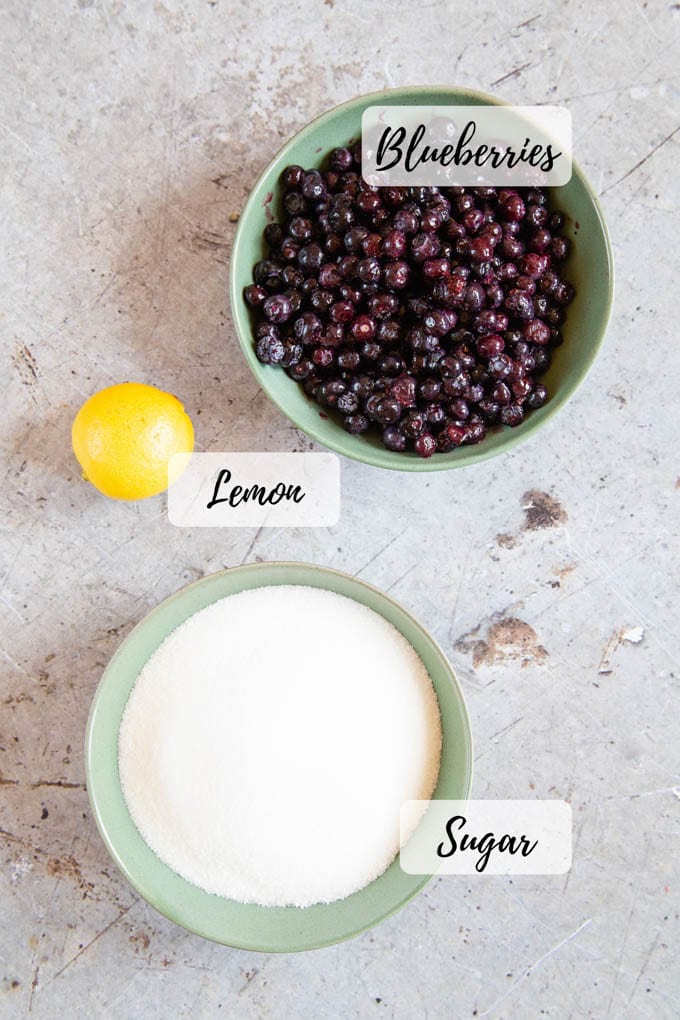
- Blueberries – fresh or frozen, use whichever is cheapest.
- Sugar – regular granulated sugar, no need for jam sugar here.
- Lemon – no need to add pectin to your blueberry jam – it all comes from the lemon juice!
Why Do I Need a Lemon to Make Jam Set?
Lemon juice contains pectin, which is what you need to make the jam set.
Many older recipes for preserves do not use lemon to help set jams and jellies. None of my vintage jam books (or any published before 2000) uses lemon in blueberry jam recipes, but I find I need to add some to get a set.
I suspect that this is because modern varieties of fruit are bred to be sweeter (and larger), and the berries are sold riper. This means they will have proportionally less pectin.
My easy blackberry jam has a far firmer set when made with wild blackberries than shop bought berries, as the fruit is completely different. Wild fruits are smaller and sharper and I’d wager contain far more pectin.
So if Granny’s tried and tested family recipe for a jam that you remembered enjoying as a child doesn’t work for you, it will almost invariably be that Granny foraged or grew her fruit and you have grown or bought a modern variety of the same fruit with less pectin.
It is the fruit that is different, not a fault in your jam making skills. Just add some lemon juice!
I far prefer the more natural soft set that comes from adding lemon juice to jam and jellies. Jam sugar and liquid pectin can produce a more solid, even rubbery set.
How Do I Make Blueberry Jam?
If using frozen blueberries, take them out of the freezer and let them thaw.
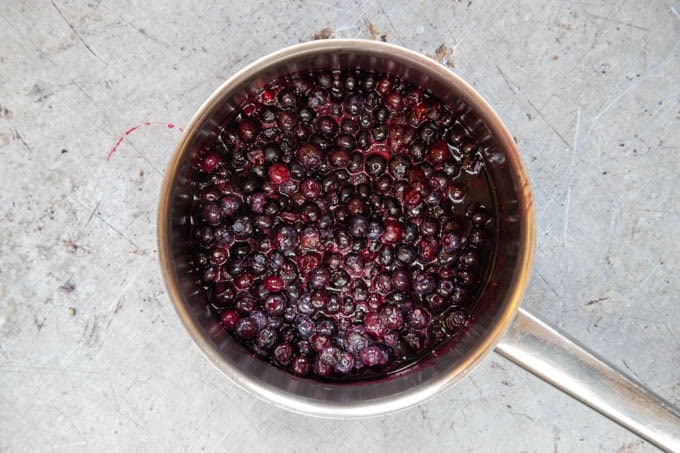
Step one – Add the blueberries to a large saucepan. If using fresh fruit, add a splash of water (you don’t need to do this if your berries are frozen). Heat on a low setting until the fruit is soft and has released its juice. Cover with a lid for fastest cooking.
Heat the oven to 140°C/Gas Mark 1, and put clean empty jars into the oven in a small roasting tray, to warm.
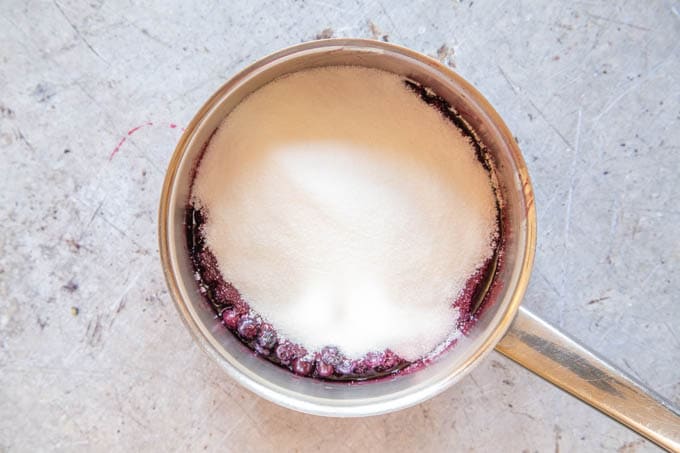
Step two – Add the sugar and lemon juice to the fruit. At this point, you may think there is far too much sugar. Don’t worry, there isn’t!
Pro tip
My top tip with lemons is to roll them under your hand on the countertop before cutting them in half and juicing. It makes much more juice come out. Try it!

Step three – Heat gently and stir to dissolve the sugar. The mixture will seem quite liquid at this point, but it will reduce.
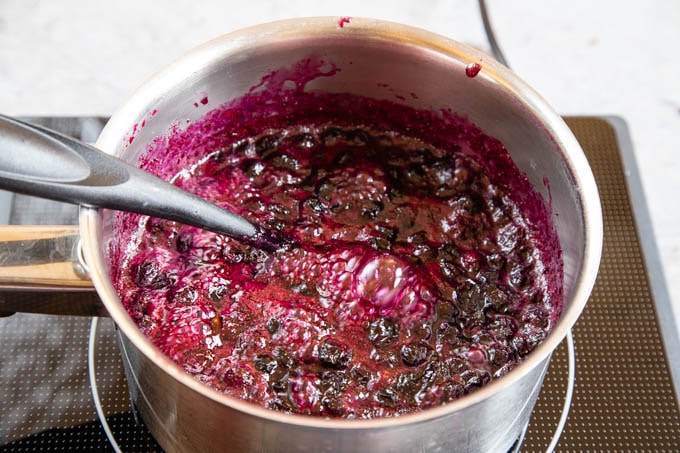
Step four – Once the sugar has dissolved, you’re ready turn up the heat to a rolling boil. It is important that the sugar has fully dissolved before you turn the heat up.
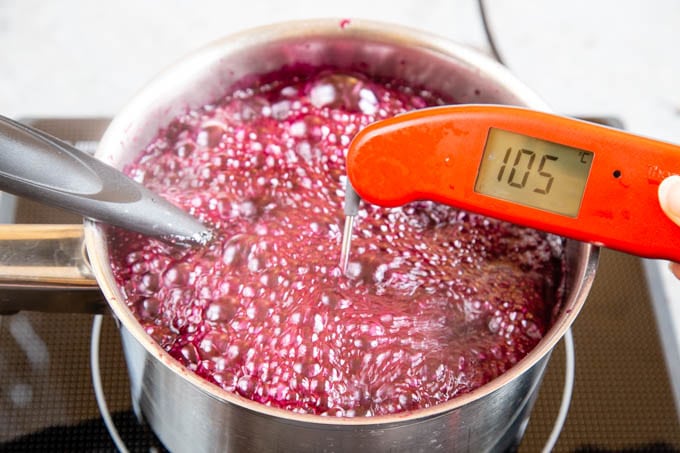
Step five – Start testing for set. Heat the jam on a high setting until you reach boiling point. Once the jam has reached a rolling boil, start testing to see if it has reached the setting point.
3 Ways of Testing Jam Setting Point
The more jams you make, the easier it will be to accurately gauge the setting point. With time, you will know when you are there just by the appearance of the bubbling jam.
- The temperature test. Accurate electronic jam thermometers are readily available, and not expensive. They are much easier to read than traditional jam thermometers. Heat the jam to the setting point (usually 105°C/221°F) and once it’s there, you know it should be ready.
Caution: Use temperature only as a guide. Once the thermometer reads 105°C, I give the jam a good stir to get rid of any hot spots and then test with the wrinkle test.- The wrinkle test. Place a couple of side plates in the freezer before you start making your jam. Once the jam is boiling, start testing by placing some on one of the plates. Allow it to cool on the plate. Then push your finger through the jam. If you see it wrinkle up ahead of your finger, it is ready. This technique takes a bit of practice.
- The flake test. Take a spoonful from the pan and turn it vertically to tip out the jam. If the jam runs off, it hasn’t set. If, however, some sticks to the spoon in a sort of wide drip that doesn’t fall, the jam is ready. Again, this works best with some practice. What you’re looking for is a change in behaviour from the jam.

Step six – Once the jam has reached setting point, remove it from the heat. Allow to stand for a few minutes, so that the jam thickens just enough to stop the fruit floating to the top. Then use a ladle and jam funnel or a Pyrex jug to fill the jam jars. Seal with the lids.
This jam is delicious served on a slice of freshly baked no yeast bread or spread on a slice of fruit loaf.
Jam making 101
- How to make jam / jelly – everything you need to know to make batch after batch of delicious jam or jelly
- For an in depth look at the how and whys read my complete guide to jam setting point
- Jam vs jelly – just what is the difference between these two preserves?
Hints & Tips
- When making this blueberry jam, trust the recipe. When you add the sugar it looks like there is far too much. Don’t be tempted to cut down on the sugar – the jam won’t set without it.
- Likewise, when you start to cook the berries and sugar, it looks far too runny. Don’t worry. This is normal and the liquid will start to evaporate quite quickly.
- Make sure the sugar has fully dissolved before you bring the jam up to a rolling boil. this will help prevent sugar crystals forming in the finished jam.
- To fill the jars, put them in a roasting tray. That way, if one cracks (this happens very rarely) the hot jam is contained, as are any drips.
- As the jam cools, the lid will pop as the jars seal – one of my favourite noises in the kitchen. As long as this happens, the jam will keep for a few years in a cool cupboard. Once open, keep it in the fridge. It will last for several weeks.
- Allow to cool, check the jars are sealed, stick a label on and enjoy. If you have any excess jam, spoon it into a small bowl and enjoy over the next day or so (once it’s cool).
- I like to add a spoon of blueberry jam to the bottom of the pot when making lemon posset.

More Jams!
We love making jams, jellies and other preserves so you are in the right place for all the help and recipes you need to stock your cupboard with delicious preserves.
- 4 nectarines make 2 delicious jars of nectarine jam
- Plum jam is delicious and easy to make
- a classic – blackberry and apple jam
- Rhubarb jam is pretty and pink and a ideal use of new season rhubarb
- a twist on a classic – try pear and blackberry jam
- Black cherry jam is made with the conserve method with big juicy pieces of fruit
- All my jam and jelly recipes in one place to choose from
Blueberry Jam – Small Batch
Ingredients
- 500 g blueberries (frozen or fresh )
- 500 g sugar (granulated)
- ½ lemon (juice only)
Instructions
- If using frozen berries, allow them to defrost in a saucepan.
- If using the wrinkle test for the setting point, place a couple of side plates in the freezer.
- Put your jam jars in a small roasting dish in the oven to sterilize at 100°C/220°F/Gas Mark 1 while you make the jam.
- Place the fruit in a large saucepan. Simmer gently until soft. If using fresh fruit, add a splash of water. (Frozen berries will be wet enough to use without adding any.)
- Once the fruit is soft, add the sugar and lemon juice. Simmer the mixture to dissolve the sugar. Keep stirring.
- Once all the sugar has dissolved, turn up the hob and heat the jam quickly to a rolling boil. After a couple of minutes, start testing the jam's set using your favourite method.
Testing for set
- Temperature: Use a jam thermometer, and check to see that the jam has reached 105°C/221°F.
- Wrinkle test: Spoon some hot jam onto a chilled plate and see if it wrinkles ahead of your finger when pushed through the jam.
- Flake test: Allow the jam to run off a spoon with the bowl held vertically. When a flake of jam remains attached to the lip of the spoon, it has reached the setting point.
After reaching setting point
- Once the jam has reached the setting point, turn off the heat and allow it to cool for about 10 minutes. This allows the jam to thicken slightly, so that the fruit pieces don’t all float to the top in the jars.
- Pour the jam into the hot jars and seal the lids. Allow to cool completely. Label and enjoy! Store in a cool, dry place.
Notes
- This recipe is 3 Weight Watchers Smart Point per portion

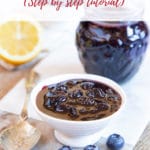
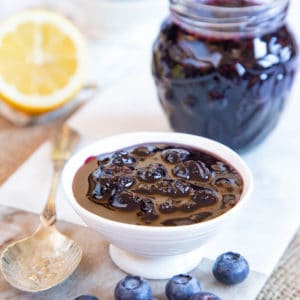

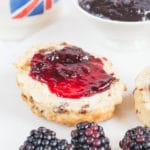
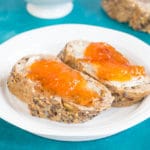

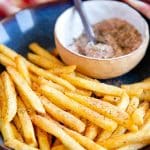
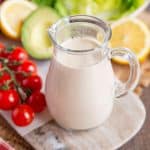






Melanie
Your jam recipes always make me want to try them, and this one was a perfect success. Thank you so much. Really good on toast!
Erin
Such an interesting read Helen, I didn’t know what the lemon juice was for. The jam is delicious too, wonderfully fruity and flavorsome.
Nic | Nic's Adventures & Bakes
Thanks for sharing, this jam looks easy to make :)
Lottie
Great results making this jam, it has to be a favourite. Fantastic breakfast jam, perfect in porridge.
Tasha
Another successful jam batch for my jam cupboard. Love the colour and tastes amazing.
Ursula Peters
Lovely proper fruity jam. It looks amazing, and tastes amazing and I had no problems with setting.
Sally
I’m growing blueberries this year, so this will be ideal when it comes to harvest time. I’ll be honest and don’t think I’ve ever tried blueberry jam, so it’ll be even more special when they are home-grown.
Hannah B
I have had another successful go at making jam, all thanks to you Helen. My new found love, it really is satisfying. I did use frozen berries and it worked perfectly fine.
Naomi
I do like your easy to follow recipe for jam making, and the tips are really helpful. Good results here.
Beverley Carter
Blueberry jam is my favourite breakfast addition. Great on toast and crumpets. This makes the perfect amount and the jam is truly delicious.
Neil Barns
Blueberries make surprisingly good jam. Your recipe is really good with clear instructions and steps. Lovely.
Mrs. Bell
Perfectly set jam with a wonderful flavour. Love the colour too. I find making the small amounts far less stressy and really enjoyable.
Heather
Delicious breakfast jam, perfect for toast and crumpets. I had great results first time with no dramas.
Lucinda
So nice to see a jam recipe from outside the USA, where every jam recipe tells you to process jars in a water bath for ten minutes, or else you will probably die of botulism or worse yet, kill your neighbor to whom you gifted a jar at Christmas time. I learned to make jam in Ireland, where one didn’t even use lids, we used a special paper and the jam was fine!
Helen
Thanks Lucinda, I think that preserving in sugar / vinegar is completely safe – canning is a whole different ball game that I really know very little about and don’t have the equipment or expertise to try.
Sharon
Can I use bottled lemon juice or does it need to be fresh?
Helen Best-Shaw
Bottled will work really well as a direct swap
Stacey
Setting point varies by altitude! My jam was really overcooked & gummy using a sea level set temp of 220F. In Denver at 5280’, set temp is 210F. Sad!
On another note, I added 25-30 sage leaves when boiling then removed them before jarring which was delicious.
Helen Best-Shaw
Hi Stacey, you are right it does vary – I’m in the UK and it is really not an issue here – but it is a good point and I do only use temperature as a guideline and will always test for set with the flake or wrinkle test too. the more times you make jam the easier it becomes to judge just from the appearance of the boiling jam.